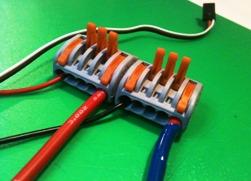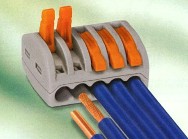Categories: Featured Articles » Electrician at home
Number of views: 262,409
Comments on the article: 28
Wago terminal blocks in home wiring
 Here is a seemingly simple question: “How to connect cable cores in home wiring?” Meanwhile, when it occurs, it usually causes controversy among electricians.
Here is a seemingly simple question: “How to connect cable cores in home wiring?” Meanwhile, when it occurs, it usually causes controversy among electricians.
Simple twist? - Forbidden and unreliable. Wire welding? - It seems to be reliable, but PUE still requires certified clamps. PPE caps? - Many do not trust them, believing that they are no better than twisting with electrical tape. ZVI insulated screw clamps? - Big and not very comfortable.
It is thought that if all electricians were familiar with WAGO terminal blocks, these disputes would be less. What are the advantages of these terminals, and how are they good?
The main feature of the WAGO terminal blocks is that they are screwless. For those who do not yet know, let us know that the design screwless terminal connection was developed in the German company WAGO in the distant 1951.
 The screwless terminal block is fundamentally different in that its installation does not require any tools and skills: the stripped wire is easily inserted into its place and reliably pressed by a spring. It would seem, well, what nonsense - just a terminal block without a screw! But in fact, the WAGO screwless terminal blocks demonstrate to us that truly ingenious things are always simple.
The screwless terminal block is fundamentally different in that its installation does not require any tools and skills: the stripped wire is easily inserted into its place and reliably pressed by a spring. It would seem, well, what nonsense - just a terminal block without a screw! But in fact, the WAGO screwless terminal blocks demonstrate to us that truly ingenious things are always simple.
First of all, using a screwless terminal block, you can not be afraid that you will damage the wire, or that the connection will be too weak and will not provide contact - the built-in spring acts precisely with the force that is necessary. Thus, the connection will never heat up, and the wire will never break. Well, and in addition, WAGO terminals simply save time and effort during installation - after all, inserting wires into the terminals without a screwdriver can be very quick and easy.
In fact, WAGO produces terminal blocks for mounting on a DIN rail, and for fastening with screws to a flat surface, but when installed as part of a home wiring, they are used construction terminal blocks. These terminal blocks are available in three types: for junction boxes, for fixtures and universal fixtures.
 WAGO terminal blocks for junction boxes allow you to connect from one to eight conductors with a cross section of 1.0-2.5 square meters. mm or three conductors with a cross section of 2.5-4.0 square meters. mm A terminal blocks for fixtures connect 2-3 conductors with a cross section of 0.5-2.5 square meters. mm
WAGO terminal blocks for junction boxes allow you to connect from one to eight conductors with a cross section of 1.0-2.5 square meters. mm or three conductors with a cross section of 2.5-4.0 square meters. mm A terminal blocks for fixtures connect 2-3 conductors with a cross section of 0.5-2.5 square meters. mm
At the same time, there is good news for electricians who, for some reason, are forced to carry out the installation of home wiring with aluminum wires. Aluminum forms an oxide film that reduces the conductivity of the contact compound. Moreover, the film is formed so quickly that, no matter how you strip the conductor, any connection will need a systematic revision and broaching of contacts.
And WAGO designers gracefully solved this problem by developing modifications of screwless terminal blocks filled with special conductive paste. This paste removes oxide film from aluminum wires, eliminating all issues associated with the use of aluminum in wiring.
Well, if you need to connect several wires with different sections in your home wiring, then you will come in handy universal terminal blocks WAGO, with which you can connect up to 5 copper wires with a cross section from 0.08 to 4.0 square meters. mm
So, summing up, we note that WAGO terminal blocks in home wiring - it is compact and reliable wire connection, regardless of installation location. In addition, it is the ability to measure network parameters without a connection connector, which fully corresponds to the “set and forget” advertising slogan. And, of course, it’s fire and electrical safety.
In continuation of the topic: How are the WAGO terminal blocks arranged?
See also at bgv.electricianexp.com
:
